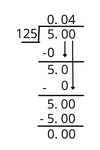This fraction to decimal calculator can convert the fraction value into decimal value.
<iframe src="https://calculatorhub.org/?cff-form=65" style="width:100%;height:100%;"></iframe>
Fraction
A fraction is a number formed by the ratio of two integers. If n and d are two integers, then n/d is a fraction as long as d is not equal to zero; otherwise, the fraction is undefined. Fractions can be both positive and negative.
The numerator is the highest number in a fraction, while the denominator is the lowest. The fraction is incorrect if the numerator is greater than the denominator.
Decimal
A decimal fraction is another name for a decimal. A decimal is the same as a suitable fraction with a denominator of 10, 100, 1000, or higher powers of 10, but without the denominator and with the decimal point.
It is possible for a decimal to be negative.
Fraction to Decimal Calculator Use
- In the first field, type the fraction value you want to convert to decimal.
- Make sure to input the faction value in the appropriate format, such as : 1/25, 5/85, 8/6, and so on.
- The calculator will convert the entered value to decimal automatically.
How to Convert Fraction to Decimal
There are many tips and tricks to convert a fraction value into a decimal. But here we will focus on only 2 methods which are among the simplest of the list, so that even a school student can easily understand the process in converting fraction to decimal.
Method 1 : Multiplication
Example :
1. Convert fraction value 5/125 into decimal.
Solution :
This problem may appear difficult because the denominator’s value is large in comparison to the numerator, but don’t fear, we’re here to help.
All we have to do now is find a number that can convert the denominator value to the 10, 100, 1000, and so on to the power of 10. We can only get to this number by multiplying.
Because the denominator is 125, we may multiply it by 8 to get 1000. Multiply the numerator and denominator by eight now.
5×8/125×8 = 40/1000 = 0.04
You might be puzzled as to how 0.04 was determined as the solution. We’ll break it down for you in the simplest terms possible.
The new fraction is 40/1000 after multiplying the original fraction by 8. One thing is obvious: when we convert a fraction to a decimal, the outcome will be in decimals. However, we have no idea how many zeros will be in this decimal.
To do so, there is a simple trick with the formula below:
Numbers in denominator – Numbers in numerator = 4 – 2 = 2 (zeros)
Our final result will have 2 zeros in total. Now just put those 2 zeros in the numerator and place a dot after first decimal, that your answer.
40/1000 = 0040/1000 = 0.040 ≈ 0.04
Method 2 : Long Division
Example :
1. Convert fraction value 5/125 into decimal.
Solution :
If the digits are greater than 2, it can be difficult and time consuming to convert fractions using the first method. As a result, the long division method makes it simple to handle such problems.
Below image shows the conversion method by long division method.

In this case we inserted extra zeros and did 5.00/125 to get 0.04
Fraction ↔︎ Decimal Conversion Table
| Fraction | Decimal |
| 1/2 | 0.5 |
| 1/3 | 0.33332 |
| 1/4 | 0.25 |
| 1/5 | 0.2 |
| 1/6 | 0.16667 |
| 1/7 | 0.14286 |
| 1/8 | 0.125 |
| 1/9 | 0.11110 |
| 1/10 | 0.1 |
| 2/3 | 0.66667 |
| 2/4 | 0.5 |
| 2/5 | 0.4 |
| 2/6 | 0.33332 |
| 2/7 | 0.28570 |
| 2/8 | 0.25 |
| 2/9 | 0.22221 |
| 2/10 | 0.2 |
| 3/4 | 0.75 |
| 3/5 | 0.6 |
| 3/6 | 0.5 |
| 3/7 | 0.42856 |
| 3/8 | 0.375 |
| 3/9 | 0.33332 |
| 3/10 | 0.3 |
| 4/5 | 0.8 |
| 4/6 | 0.66665 |
| 4/7 | 0.57143 |
| 4/8 | 0.5 |
| 4/9 | 0.44443 |
| 4/10 | 0.4 |
| 5/6 | 0.83332 |
| 5/7 | 0.71428 |
| 5/8 | 0.625 |
| 5/9 | 0.45556 |
| 5/10 | 0.5 |